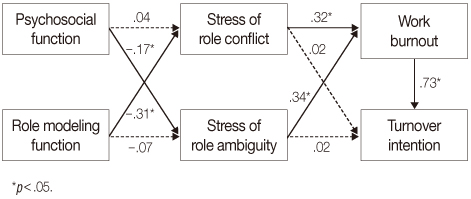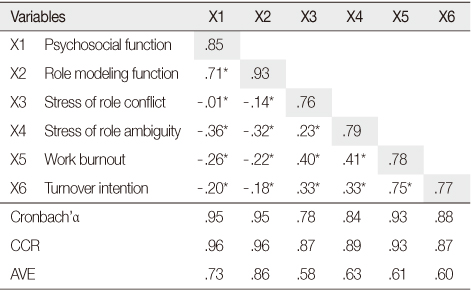Articles
- Page Path
- HOME > J Korean Acad Nurs > Volume 43(5); 2013 > Article
-
Original Article
- Effects of Nurses' Mentoring on Turnover Intention: Focused on the Mediating Effects Role Stress and Burnout
- Sangsook Han, Ohsook Kim, Yunsu Joo, Eunduck Choi, Jeongwon Han
-
Journal of Korean Academy of Nursing 2013;43(5):605-612.
DOI: https://doi.org/10.4040/jkan.2013.43.5.605
Published online: October 31, 2013
1College of Nursing Science, East-West Nursing Research Institute, Kyung Hee University, Seoul, Korea.
2College of Nursing Science, Kyung Hee University, Seoul, Korea.
- Address reprint requests to: Han, Jeongwon. College of Nursing Science, Kyung Hee University, 1 Hoegi-dong, Dongdaemun-gu, Seoul 130-701, Korea. Tel: +10-4448-4475, Fax: +82-2-961-9398, hjw0721@naver.com
© 2013 Korean Society of Nursing Science
Abstract
-
Purpose
- The purpose of this study was to investigate the casual relationship between nurses' mentoring and turnover intention and to verify the goodness of fit between a hypothetical model and actual data in order to suggest an adequate model.
-
Methods
- The survey was conducted with 434 nurses working in general hospitals in Seoul. Data were collected during February 2013, and analyzed with SPSS Windows 18.0 and AMOS 7.0.
-
Results
- Mentoring was found to have a direct effect on decrease in role stress. Role stress had a direct effect on increase in burnout and mentoring, with role stress as a mediator, there was an indirect effect on burnout. Burnout had a direct effect on increase in turnover intention, and role stress, with burnout as a mediator, and mentoring, through role stress and burnout, an indirect effect was found on increase in turnover intention.
-
Conclusion
- The results of this study indicate that nursing managers should put effort into reducing role stress and burnout, while seeking to establish a more efficient mentoring system so that for nurses, there will be a lowering of turnover intention.
- 1. Bluedorn AC. The theories of turnover: Causes, effects and meaning. Res Sociol Organ. 1982;1:75–128.
- 2. Carlson DS, Kacmar KM. Work-family conflict in the organization: Do life role values make a difference? J Manag. 2000;26(5):1031–1054. http://dx.doi.org/10.1177/014920630002600502Article
- 3. Cheon SD, Lee EY, Lee SG, Lee SB. A study about influence on job stress factors with leader-member exchange, job satisfaction, organizational commitment and intention of turnover. Korea J Tourism Hosp Res. 2006;20(1):17–34.
- 4. Dreher GF, Ash RA. A comparative study of mentoring among men and women in managerial, professional, and technical positions. J Appl Psychol. 1990;75(5):539–546.Article
- 5. Garrosa E, Moreno-Jiménez B, Rodríguez-Muñoz A, Rodríguez-Carvajal R. Role stress and personal resources in nursing: A cross-sectional study of burnout and engagement. Int J Nurs Stud. 2011;48(4):479–489. http://dx.doi.org/10.1016/j.ijnurstu.2010.08.004ArticlePubMed
- 6. Jeong JH, Kim JS, Kim KH. The risk factors influencing turnover intention of nurses. J Korean Acad Nurs Adm. 2008;14(1):35–44.
- 7. June KJ, Byun SW. Nurse's burnout research throughout the past 10 years in Korea. J Korean Acad Nurs Adm. 2009;15(3):305–313.
- 8. Kim GS, Kim HY, Koh HJ. The relationship between mentoring and job stress of nurses in small and medium. Keimyung J Nurs Sci. 2011;15(1):31–40.
- 9. Kim YS. Nurses job stress influencing on the burnout and turnover intentions. Seoul, Kyung Hee University. 2011;Unpublished master's thesis.
- 10. Lankau MJ, Carlson DS, Nielson TR. The mediating influence of role stressors in the relationship between mentoring and job attitudes. J Vocat Behav. 2006;68(2):308–322. http://dx.doi.org/10.1016/j.jvb.2005.06.001Article
- 11. Lee HC. The study of the relationship among military hospital nursing's job stress, burnout and intention of turnover. Taipei, Ming Chuan University. 2010;Unpublished master's thesis.
- 12. Lee KJ, Lee E. The relationship of emotional labor, empowerment, job burnout and turnover intention of clinical nurses. Korean J Occup Health Nurs. 2011;20(2):130–142.Article
- 13. Lee SD. A study on the influence of the mentoring at fast food business on the role stress, and turnover intention. Gyeongsan, Daegu University. 2005;Unpublished master's thesis.
- 14. Lee SO, Lee SE. Nursing research. Seoul: Korea National Open University Press; 2002.
- 15. Leiter MP, Maslach C. Nurse turnover: The mediating role of burnout. J Nurs Manag. 2009;17(3):331–339. http://dx.doi.org/10.1111/j.1365-2834.2009.01004.xArticlePubMed
- 16. Lim JM, Kim MJ. The effect of the mentoring function on hotel employeerole stress, job attitude and turnover intention. In: Paper presented at the 31th Conference of Korea Academic Society of Tourism Management; 2008. 02.
- 17. Maslach C, Schaufeli WB, Leiter MP. Job burnout. Annu Rev Psychol. 2001;52:397–422. http://dx.doi.org/10.1146/annurev.psych.52.1.397ArticlePubMed
- 18. Mobley WH. Employee turnover: Causes, consequences and control. Reading, MA: Addison-Wesley; 1982.
- 19. Moon SJ, Han SS. A predictive model on turnover intention of nurses in Korea. J Korean Acad Nurs. 2011;41(5):633–641. http://dx.doi.org/10.4040/jkan.2011.41.5.633ArticlePubMed
- 20. Pines AM, Aronson E, Kafry D. Burn out: From tedium to personal growth. New York, NY: Free Press; 1981.
- 21. Rizzo JR, House RJ, Lirtzman SI. Role conflict and ambiguity in complex organizations. Adm Sci Q. 1970;15(2):150–163.Article
- 22. Scandura TA. Mentorship and career mobility: An empirical investigation. J Organ Behav. 1992;13(2):169–174. http://dx.doi.org/10.1002/job.4030130206Article
- 23. Seo YS, Kim YC. A study on factors affecting the turnover intention and job involvement of nurses. Korean Bus Educ Rev. 2007;12:151–172.
- 24. Son EJ. Nurses role conflicts influencing on the organizational commitments and turnover intentions. Seoul, Kyung Hee University. 2011;Unpublished master's thesis.
- 25. Sosik JJ, Godshalk VM. The role of gender in mentoring: Implications for diversified and homogenous mentoring relationships. J Vocat Behav. 2000;57(1):102–122. http://dx.doi.org/10.1006/jvbe.1999.1734Article
- 26. Steers RM, Mowday RT. Employee turnover and post-decision accommodation processes. In: Cummings LL, Staw BM, editors. Research in organizational behavior. Amsterdam, Netherlands: Elsevier Science & Technology Books; 1981. p. 235–281.
- 27. Tett RP, Meyer JP. Job satisfaction, organizational commitment, turnover intention, and turnover: Path analyses based on meta-analytic findings. Pers Psychol. 1993;46(2):259–293. http://dx.doi.org/10.1111/j.1744-6570.1993.tb00874.xArticle
- 28. Viator RE. The association of formal and informal public accounting mentoring with role stress and related job outcomes. Account Organ Soc. 2001;26(1):73–93. http://dx.doi.org/10.1016/S0361-3682(00)00002-7Article
- 29. Wilson JA, Elman NS. Organizational benefits of mentoring. Exec. 1990;4(4):88–94. http://dx.doi.org/10.5465/AME.1990.4277215Article
REFERENCES
Figure & Data
REFERENCES
Citations

- Effects of horizontal violence among nurses on patient safety: Mediation of organisational communication satisfaction and moderated mediation of organisational silence
Eun Young Doo, Sujin Choi
Journal of Nursing Management.2021; 29(3): 526. CrossRef - Trends in Turnover Research on Korean Nurses: Based on 8 Journals Published by Member Societies under the Korean Academy of Nursing Science, 2006-2015
Hyo Geun Geun
The Open Nursing Journal.2019; 13(1): 92. CrossRef - Prevalence of burnout in mental health nurses and related factors: a systematic review and meta‐analysis
Isabel María López‐López, José Luis Gómez‐Urquiza, Gustavo Raúl Cañadas, Emilia Inmaculada De la Fuente, Luis Albendín‐García, Guillermo Arturo Cañadas‐De la Fuente
International Journal of Mental Health Nursing.2019; 28(5): 1035. CrossRef - Job burnout and turnover intention among nurses in China: the mediating effects of positive emotion
Li-Feng Yang, Jing-Ying Liu, Yan-Hui Liu
Frontiers of Nursing.2018; 5(1): 43. CrossRef - Attitude, Role Perception and Nursing Stress on Life Sustaining Treatment among Intensive Care Unit Nurses
Su Jeong Lee, Hye Young Kim
Korean Journal of Adult Nursing.2017; 29(2): 131. CrossRef - Don’t abandon hope all ye who enter here: The protective role of formal mentoring and learning processes on burnout in correctional officers
M.L. Farnese, B. Barbieri, B. Bellò, P.T. Bartone
Work.2017; 58(3): 319. CrossRef - Effect of Nurses' Mentoring Function and Organizational Citizen Behavior on Nursing Performance
Kyung-Hee Park, Jeong Won Han
Journal of the Korea Academia-Industrial cooperation Society.2016; 17(2): 179. CrossRef - Factors Affecting Turnover Intention in Pediatric Nurses
Min Suk Im, Young Eun Lee
Child Health Nursing Research.2016; 22(1): 37. CrossRef - The effect of perceived organisational support on burnout among community health nurses in China: the mediating role of professional self-concept
Xiaoyi Cao, Lin Chen, Lang Tian, Yongshu Diao
Journal of Nursing Management.2016; 24(1): E77. CrossRef - Covariance Structure Analysis on the Impact of Job Stress, Fatigue Symptoms and Job Satisfaction on Turnover Intention among Dental Hygienists
Se-Young Han, Young-Chae Cho
Journal of the Korea Academia-Industrial cooperation Society.2016; 17(7): 629. CrossRef - Effect of professional self‐concept on burnout among community health nurses in Chengdu, China: the mediator role of organisational commitment
Xiaoyi Cao, Lin Chen, Lang Tian, Yongshu Diao, Xiuying Hu
Journal of Clinical Nursing.2015; 24(19-20): 2907. CrossRef - Literature Review of Structural Equation Models for Hospital Nurses' Turnover Intention in Korea
Eunhye Kim, Jinhyun Kim
Perspectives in Nursing Science.2014; 11(2): 109. CrossRef

Figure 1
Correlations and Discriminant Validity of the Model
*p<.001; The shaded section: discriminant validity; The non shaded section: correlation; CCR=Composite construct reliability; AVE=Average variance extracted.
The Result of Path Coefficient
β=Standardized regression weights; B=Regression weights; SE=Standardized error; CR=Critical ratio.
Fit Statistics for the Measurement Model
GFI=Goodness of fit index; AGFI=Adjusted goodness of fit index; NFI=Normed fit index; CFI=Comparative fit index; RMR=Root mean residual; RMSEA=Root mean squared error of approximation.
Effects of Predictor Variables in the Model
SMC=Squared multiple correlation.
*
β=Standardized regression weights; B=Regression weights; SE=Standardized error; CR=Critical ratio.
GFI=Goodness of fit index; AGFI=Adjusted goodness of fit index; NFI=Normed fit index; CFI=Comparative fit index; RMR=Root mean residual; RMSEA=Root mean squared error of approximation.
SMC=Squared multiple correlation.
 KSNS
KSNS
 E-SUBMISSION
E-SUBMISSION





 Cite
Cite

